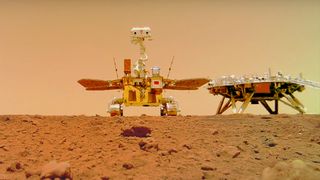China silent on fate of Zhurong Mars rover on 2nd anniversary of Tianwen 1 mission
Tianwen 1, China's first interplanetary mission, marked its second anniversary in orbit around Mars on Feb. 10, but there was no update on the status of the mission's Zhurong rover.

China's first interplanetary mission marked its second anniversary in orbit around Mars on Feb. 10, but there was no update on the status of the mission's rover.
The Tianwen 1 mission's Zhurong rover entered hibernation in May 2022 due to declining solar power available to the spacecraft during winter in Mars' northern hemisphere.
Zhurong was expected to wake up in December, around the time of the spring equinox, but China and its space authorities have remained silent on the status of the rover.
Related: Will China's Zhurong Mars rover wake up from its worrying hibernation?
Chinese state media marked the second anniversary with short articles highlighting the achievements of the Tianwen 1 Mars orbiter with only brief mentions of Zhurong. No new images from the orbiter have been released.
Zhurong was expected to wake up autonomously when two conditions are met. These are key components reaching a temperature of greater than 5 degrees Fahrenheit (minus 15 degrees Celsius) and energy generation of greater than 140 watts. Both conditions were predicted to be reached in December.
The rover does not carry a radioisotope heater unit, like other rovers including China's Yutu moon explorers, but instead has a pair of "windows" allowing a chemical called n-undecane to store heat energy. The substance absorbs heat and melts during the day, and solidifies and releases heat at night, according to Chinese state media.
Get the Space.com Newsletter
Breaking space news, the latest updates on rocket launches, skywatching events and more!
Dust storms in Utopia Planitia may have impacted the rover's ability to generate heat and light. This could potentially be the issue explaining Zhurong's silence, and may leave hope that the rover reactivates in warmer conditions or when the Martian wind cleans its solar arrays.

Tianwen 1 has, despite the apparent issue with Zhurong's continued operation, been a huge success. The mission is China's first independent interplanetary expedition and made the country only the second after the United States to successfully land and operate a rover on Mars.
Both the Tianwen 1 orbiter and Zhurong have completed their primary missions and won international awards. Updates were also previously provided when the Yutu lunar rover suffered locomotive failure in early 2014. China, however, remains silent on the fate of Zhurong.
Tianwen 1 was one of three missions that arrived at Mars in February 2021, along with NASA's Perseverance rover and the United Arab Emirates' (UAE) Hope orbiter.
The nuclear-powered Perseverance landed on Feb. 18, and the mission has been active ever since. It has a regularly updated, dedicated NASA mission page.
The UAE announced on the second anniversary of Hope's orbital insertion that the spacecraft would adjust its orbit to closely study Mars' tiny moon Deimos.
China is planning a Mars sample return mission named Tianwen 3, to launch as soon as 2028.
Follow us on Twitter @Spacedotcom and on Facebook.
Join our Space Forums to keep talking space on the latest missions, night sky and more! And if you have a news tip, correction or comment, let us know at: community@space.com.

Andrew is a freelance space journalist with a focus on reporting on China's rapidly growing space sector. He began writing for Space.com in 2019 and writes for SpaceNews, IEEE Spectrum, National Geographic, Sky & Telescope, New Scientist and others. Andrew first caught the space bug when, as a youngster, he saw Voyager images of other worlds in our solar system for the first time. Away from space, Andrew enjoys trail running in the forests of Finland. You can follow him on Twitter @AJ_FI.